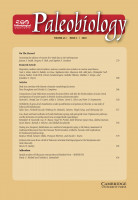“Geographic range size and abundance are important determinants of extinction risk in fossil and extant taxa. However, the relationship between these variables and extinction risk has not been tested extensively during evolutionarily “quiescent” times of low extinction and speciation in the fossil record. Here we examine the influence of geographic range size and abundance on extinction risk during the late Paleozoic (Mississippian–Permian), a time of “sluggish” evolution when global rates of origination and extinction were roughly half those of other Paleozoic intervals. Analyses used spatiotemporal occurrences for 164 brachiopod species from the North American midcontinent. We found abundance to be a better predictor of extinction risk than measures of geographic range size. Moreover, species exhibited reductions in abundance before their extinction but did not display contractions in geographic range size. The weak relationship between geographic range size and extinction in this time and place may reflect the relative preponderance of larger-ranged taxa combined with the physiographic conditions of the region that allowed for easy habitat tracking that dampened both extinction and speciation. These conditions led to a prolonged period (19–25 Myr) during which standard macroevolutionary rules did not apply.” Link to article

